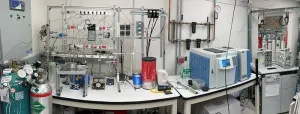(Press-News.org) CORVALLIS, Ore. – A new study investigating ancient methane trapped in Antarctic ice suggests that global increases in wildfire activity likely occurred during periods of abrupt climate change throughout the last Ice Age.
The study, just published in the journal Nature, reveals increased wildfire activity as a potential feature of these periods of abrupt climate change, which also saw significant shifts in tropical rainfall patterns and temperature fluctuations around the world.
“This study showed that the planet experienced these short, sudden episodes of burning, and they happened at the same time as these other big climate shifts,” said Edward Brook, a paleoclimatologist at Oregon State University and a co-author of the study. “This is something new in our data on past climate.”
The findings have implications for understanding modern abrupt climate change, said the study’s lead author, Ben Riddell-Young, who conducted the research as part of his doctoral studies in OSU’s College of Earth, Ocean, and Atmospheric Sciences.
“This research shows that we may not be properly considering how wildfire activity might change as the climate warms and rainfall patterns shift,” said Riddell-Young, who is now a postdoctoral scholar at the Cooperative Institute for Research in Environmental Sciences at the University of Colorado, Boulder.
Ice that built up in Antarctica over tens to hundreds of thousands of years contains ancient air bubbles. Scientists use samples of that ice, collected by drilling cores, to analyze the gasses preserved in these bubbles and build records of the Earth’s past climate.
Previous research has shown that levels of atmospheric methane, a greenhouse gas, spiked during abrupt climate change periods during the last Ice Age, which ended about 11,000 years ago. These abrupt climate change events, known as Dansgaard-Oeschger and Heinrich events, were associated with rapid regional temperature changes and shifting rainfall patterns, as well as spikes in atmospheric methane. The goal of the study was to try to determine what caused those spikes.
“These spikes were notable because of how quickly the methane levels changed during these periods,” Riddell-Young said.
Riddell-Young used samples from the two-mile long Western Antarctic Ice Sheet Divide Ice Core and a replicate core collected with a specialized drill that reenters the core and borehole and collects more ice. The records in those cores date back 67,000 years.
“Because this ice is in a place where the annual snowfall rate is high, the record doesn’t go back as far in time as other ice cores, but you get more ice for each year, and you can better see the detail in those years,” said Brook, a professor in OSU’s College of Earth, Ocean, and Atmospheric Sciences.
Riddell-Young used a system he designed to extract the air from ice samples and then used a mass spectrometer to measure the isotopic composition of the methane, which can indicate the sources of atmospheric methane.
The measured isotopic changes suggest that the spikes in methane were caused by methane emissions from an increase in wildfires globally, Riddell-Young said.
“These fire events were likely one of the cascading impacts resulting from what triggered the abrupt climate change event,” he said. “It probably went something like: Ocean currents slowed down or sped up rapidly, the northern hemisphere cooled or warmed rapidly, and then this caused abrupt shifts in tropical rainfall that lead to increased drought and fire.”
Past research has suggested that shifts in temperature and tropical rainfall were associated with these abrupt climate change periods, but the new study provides the first good evidence that fire was also a feature of these periods, Brook said.
Additional research is needed to better understand the role these periods of burning may have in climate patterns, Brook said. For example, burning produces atmospheric CO2, another greenhouse gas, which also contributes to climate warming.
“Understanding what this burning really means for the carbon cycle is one of the places the research is headed next,” he said.
The research was supported by the National Science Foundation. Additional co-authors are James Lee of the Los Alamos National Laboratory; Jochen Schmitt and Hubertus Fischer of the University of Bern; Thomas Bauska of the British Antarctic Survey; James A. Menking of the Commonwealth Scientific and Industrial Research Organization in Australia; René Iseli of the University of Fribourg; and Justin Reid Clark of the University of Colorado, Boulder.
END
Increased wildfire activity may be a feature of past periods of abrupt climate change, study finds
2025-01-02
ELSE PRESS RELEASES FROM THIS DATE:
Dogs trained to sniff out spotted lanternflies could help reduce spread
2025-01-02
Media note: Video of the Labrador retriever, Dia, in action is available for download, along with photos of the dogs and egg masses, here.
ITHACA, N.Y. - Growers and conservationists have a new weapon to detect invasive spotted lanternflies early and limit their spread: dogs trained to sniff out egg masses that overwinter in vineyards and forests.
A Cornell University study found that trained dogs – a Labrador retriever and a Belgian Malinois – were better than humans at detecting egg masses in forested areas near vineyards, while people spotted them better than the dogs in vineyards.
The spotted lanternfly, which was first ...
New resource available to help scientists better classify cancer subtypes
2025-01-02
GRAND RAPIDS, Mich. (Jan. 2, 2025) — A multi-institutional team of scientists has developed a free, publicly accessible resource to aid in classification of patient tumor samples based on distinct molecular features identified by The Cancer Genome Atlas (TCGA) Network.
The resource comprises classifier models that can accelerate the design of cancer subtype-specific test kits for use in clinical trials and cancer diagnosis. This is an important advance because tumors belonging to different subtypes may vary in their response to cancer therapies.
The resource is the first of its kind to bridge the gap between TCGA’s immense data library ...
What happens when some cells are more like Dad than Mom
2025-01-02
NEW YORK, NY--New work by Columbia researchers has turned a textbook principle of genetics on its head and revealed why some people who carry disease-causing genes experience no symptoms.
Every biology student learns that each cell in our body (except sperm and eggs) contains two copies of each gene, one from each parent, and each copy plays an equal part in the cell.
The new study shows that some cells are often biased when it comes to some genes and inactivate one parent’s copy. The phenomenon was discovered about a decade ago, but ...
CAR-T cells hold memories of past encounters
2025-01-02
AURORA, Colo. (Jan. 2, 2025) - Researchers at the University of Colorado Anschutz Medical Campus have discovered that some CAR-T cells engineered to fight cancer and other conditions carry the memory of past encounters with bacteria, viruses and other antigens within them, a finding that may allow scientists to manufacture the cells in more precise and targeted ways.
The study, published today in the journal Nature Immunology, focused on chimeric antigen receptor (CAR)-T cells, an effective therapy against ...
Quantity over quality? Different bees are attracted to different floral traits
2025-01-02
UNIVERSITY PARK, Pa. — When it comes to deciding where they’re going to get their next meal, different species of bees may be attracted to different flower traits, according to a study led by researchers at Penn State and published in PNAS Nexus.
The study focused on two species of solitary bees: the horned-face bee, which helps pollinate crops like apples and blueberries, and the alfalfa leafcutting bee, which pollinates alfalfa.
The researchers found that the horned-face bees tended to prefer plants with a large number of flowers — for them, quantity was most important. ...
Cancer-preventing topical immunotherapy trains the immune system to fight precancers
2025-01-02
A new study by investigators from Mass General Brigham uncovers how a novel immunotherapy prevents squamous cell carcinoma, with benefits lasting five years after treatment. This therapy is the first to activate specific components of the adaptive immune system, particularly CD4+ T helper cells, which are not known to be involved in traditional cancer treatments. This work highlights the potential for similar immunotherapies to prevent other cancers throughout the body. Results are published in the Journal of Clinical Investigation.
“One of the unique challenges with squamous cell carcinoma is that individuals who develop it are at an increased risk of developing multiple new ...
Blood test can predict how long vaccine immunity will last, Stanford Medicine-led study shows
2025-01-02
When children receive their second measles-mumps-rubella vaccine, around the time they start kindergarten, they gain protection against all three viruses for all or most of their lives. Yet the effectiveness of an influenza vaccine given in October starts to wane by the following spring.
Scientists have long been stymied by why some vaccines can coax the body to produce antibodies for decades, while others last mere months. Now, a study led by researchers at Stanford Medicine has shown that variation in vaccine durability can, in part, be pinned on a surprising type ...
The nose knows: Nasal swab detects asthma type in kids
2025-01-02
Researchers at the University of Pittsburgh have developed a nasal swab test for kids that diagnoses specific asthma subtype, or endotype. This non-invasive approach could help clinicians prescribe medications more precisely and pave the way for research toward better treatments for lesser-studied asthma types, which have been difficult to diagnose accurately until now.
Published today in JAMA, the findings are based on data from three independent U.S.-based studies that focused on Puerto Rican and African American youths, who have higher rates of asthma and are more likely to die from the disease than their non-Hispanic white counterparts.
“Asthma ...
Knowledge and worry following review of standard vs patient-centered pathology reports
2025-01-02
About The Study: Most study participants could not extract basic information—including whether they have cancer—from standard prostate cancer pathology reports but were able to understand this diagnostic information from the patient-centered pathology reports (PCPRs). Also, they discriminated between risk levels (i.e., lower levels of perceived worry in the low-risk condition) with PCPRs compared with standard reports. Hospital systems should consider including PCPRs with standard pathology reports to improve patient understanding.
Corresponding ...
Cardiovascular disease and breast cancer stage at diagnosis
2025-01-02
About The Study: This case-control study found that individuals with more advanced breast cancer at diagnosis were more likely to have prevalent cardiovascular disease. This finding may be specific to hormone receptor–positive and ERBB2-negative (formerly HER2) disease. Future studies are needed to confirm these findings and investigate interventions to improve patient outcomes, including personalized cancer screening.
Corresponding Author: To contact the corresponding author, Kevin T. Nead, MD, MPhil, email ktnead@mdanderson.org.
To access the embargoed study: Visit our For The Media website at this link https://media.jamanetwork.com/
(doi:10.1001/jamanetworkopen.2024.52890)
Editor’s ...


